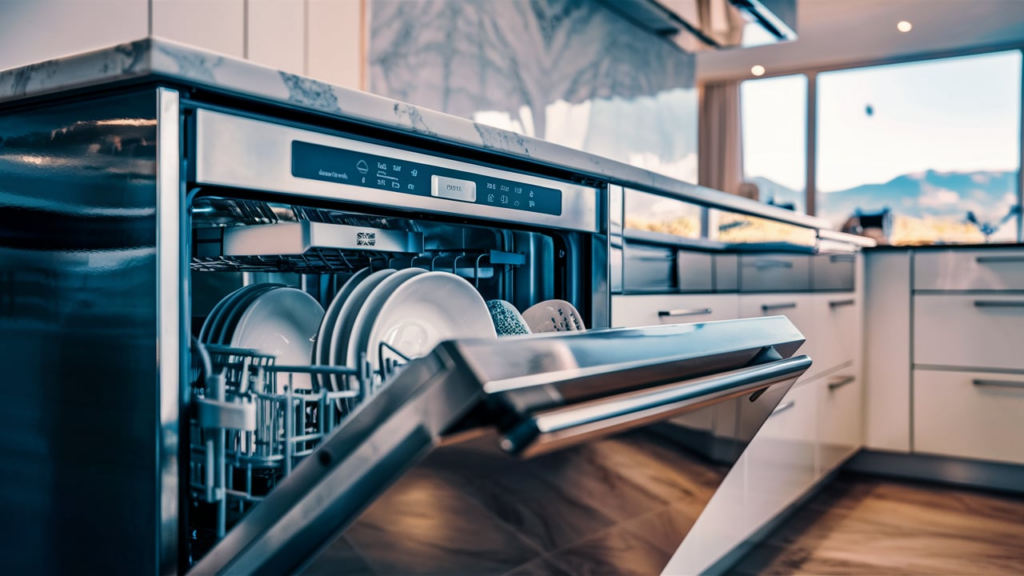
The flow sensor assembly in an LG dishwasher is a critical component that regulates the water entering the machine, so the correct levels are maintained for efficient washing cycles. If the dishwasher fails to fill properly, overfills, or displays an error code related to water flow or level, it may be time to replace the flow sensor assembly.
Common Signs of a Faulty Flow Sensor
You may notice the following symptoms when the flow sensor is not working correctly:
- Water Level Problems: The dishwasher either doesn’t fill with enough water or overfills.
- Error Codes: LG dishwashers often display error codes, such as OE, FE, or IE, indicating water flow or level issues.
- Cycles Won’t Start or Finish: The dishwasher may refuse to begin a cycle or shut off prematurely due to water regulation failures.
- Excess Noise or Water Overflow: If the sensor isn’t reading water levels accurately, unusual noises or water spills may occur.
Tools and Materials Required
- Replacement flow sensor assembly (confirm compatibility with your dishwasher model)
- Phillips screwdriver
- Flathead screwdriver
- Adjustable wrench
- Pliers
- Tape
- Towels
Verify Part Compatibility
To confirm the replacement part matches your dishwasher, locate the appliance’s model number. This is usually labeled “MOD” or “Model” and can be found in one of these areas:
- On the side panel or door frame
- On the back or bottom of the dishwasher
- On the control panel or console
Write down or take a photo of the model number for reference when purchasing the replacement part.
Prioritize Safety
Before beginning any repair work, follow these essential safety measures:
- Unplug the dishwasher or turn off the circuit breaker to eliminate the risk of electric shock.
- Turn off the water at the outlet to prevent leaks or flooding during the repair.
- If the appliance has been recently used, let it cool down before starting.
- Keep your workspace well-lit and free of clutter, and ensure children and pets are kept away.
- Never work with wet hands, and keep the area dry to prevent accidents.
- Use insulated work gloves to protect your hands from sharp edges and debris.
- Use towels to catch any residual water in the system when disconnecting components.
- Handle parts gently to avoid causing damage.
- Take photos or make detailed notes of wiring connections and terminal placements before disconnecting anything, so reassembly is easier.
- Work slowly and carefully, as rushing can lead to mistakes or injuries.
How to Replace the Flow Sensor Assembly on an LG Dishwasher
Preparation
- Unplug the dishwasher from the power outlet.
- Shut off the water supply to the dishwasher.
Removing the Dishwasher
- Remove the dishwasher from the cabinet:
- Unscrew any mounting brackets securing the dishwasher.
- Gently pull the dishwasher out of the cabinet.
- Open the door and remove both the upper and lower dish racks.
- Unscrew the air brake inlet nut.
- Close the door and tape the mounting brackets in place to keep them out of the way.
Accessing the Flow Sensor
- Lean the dishwasher back to access the bottom.
- Remove the screws securing the bottom access plate and pull the plate free.
- Detach the water flow sensor connector.
- Lift the air brake inlet to expose the flow sensor.
- Use a small flathead screwdriver to disconnect the old sensor from the air brake inlet.
Installing the New Flow Sensor
- Snap the new water flow sensor into place on the air brake inlet.
- Reconnect the wire connector to the new sensor.
Reassembly
- Reinstall the bottom access plate and secure it with the screws.
- Return the dishwasher to its upright position.
- Remove the tape holding the mounting brackets.
- Open the door and reinstall the air brake inlet nut.
- Replace the upper and lower dish racks in the dishwasher.
Reinstalling the Dishwasher
- Slide the dishwasher back into the cabinet carefully.
- Adjust the leveling legs if needed to make the dishwasher sit evenly.
- Reinstall the screws to secure the mounting brackets to the cabinet or countertop.
Final Connections
- Feed the drain hose through the cabinet and connect it to the sink drain or garbage disposer.
- Position the drain hose so it remains elevated above the connection point to prevent backflow.
- Reconnect the water supply line to the inlet valve and tighten it.
Testing
- Turn the water supply back on.
- Plug the dishwasher back into the power outlet.
- Run a test cycle to check for proper operation and any leaks.
Benefits of Regular Maintenance
Regular maintenance of your LG dishwasher can help prevent future issues with components like the flow sensor. Key practices include:
- Cleaning Filters: Regularly clean the filters to keep water flowing properly.
- Inspecting Hoses and Seals: Look for leaks or blockages that may cause water level irregularities.
- Checking for Clogs: Ensure the water inlet and outlet areas are free from obstructions, as debris can impact the sensor’s readings.
- Running Maintenance Cycles: Use dishwasher-safe cleaning agents periodically to flush out buildup that can affect components.
So, there you have it! Swapping out that faulty flow sensor is easier than you might think and can save you both time and money. No more dealing with annoying error codes or unexpected water spills. Next time your LG dishwasher throws a tantrum, you’ll know exactly what to do. Give it a try and enjoy those perfectly clean dishes without the hassle!
